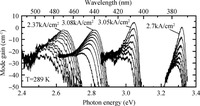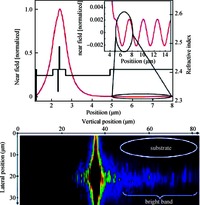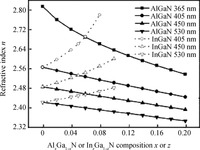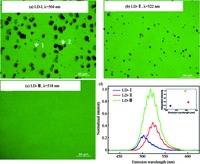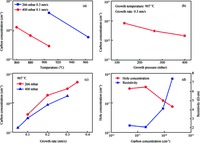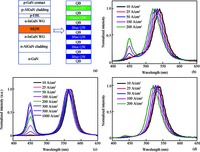| Citation: |
Lingrong Jiang, Jianping Liu, Aiqin Tian, Yang Cheng, Zengcheng Li, Liqun Zhang, Shuming Zhang, Deyao Li, M. Ikeda, Hui Yang. GaN-based green laser diodes[J]. Journal of Semiconductors, 2016, 37(11): 111001. doi: 10.1088/1674-4926/37/11/111001
****
L R Jiang, J P Liu, A Q Tian, Y Cheng, Z C Li, L Q Zhang, S M Zhang, D Y Li,M. Ikeda, H Yang. GaN-based green laser diodes[J]. J. Semicond., 2016, 37(11): 111001. doi: 10.1088/1674-4926/37/11/111001.
|
-
Abstract
Recently, many groups have focused on the development of GaN-based green LDs to meet the demand for laser display. Great progresses have been achieved in the past few years even that many challenges exist. In this article, we analysis the challenges to develop GaN-based green LDs, and then the approaches to improve the green LD structure in the aspect of crystalline quality, electrical properties, and epitaxial layer structure are reviewed, especially the work we have done. -
References
[1] Queren D, Schillgalies M, Avramescu A, et al. Quality and thermal stability of thin InGaN films. J Cryst Growth, 2009, 311:2933 doi: 10.1016/j.jcrysgro.2009.01.066[2] Schwarz U T, Scheibenzuber W G. The green laser diode:completing the rainbow. Optics & Photonics News, 2011, 22(9):38 http://cn.bing.com/academic/profile?id=2093981113&encoded=0&v=paper_preview&mkt=zh-cn[3] Jansen M, Carey G P, Carico R, et al. Visible laser and laser array sources for projection display. Proceedings of SPIE, 2006, 6135:198 http://cn.bing.com/academic/profile?id=2018046147&encoded=0&v=paper_preview&mkt=zh-cn[4] Belyanin A A, Lutgen S, Smowton P M, et al. Progress of blue and green InGaN laser diodes. Proceedings of SPIE, 2010, 7616:76160G doi: 10.1117/12.842131[5] Sizov D, Bhat R, Zah C E. Gallium indium nitride-based green lasers. J Lightw Technol, 2012, 30:679 doi: 10.1109/JLT.2011.2176918[6] Ambacher O. Growth and applications of group Ⅲ nitrides. J Phys D, 1998, 31:2653 doi: 10.1088/0022-3727/31/20/001[7] Amano H. Development of GaN-based blue LEDs and metalorganic vapor phase epitaxy of GaN and related materials. Prog Cryst Growth Charact Mater, 2016, 62:126 doi: 10.1016/j.pcrysgrow.2016.04.006[8] Kozaki T, Matsumura H, Sugimoto Y, et al. High-power and wide wavelength range GaN-based laser diodes. Proceedings of SPIE, 2006, 6133:16 http://cn.bing.com/academic/profile?id=2083136845&encoded=0&v=paper_preview&mkt=zh-cn[9] Nagahama S, Yanamoto T, Sano M, et al. Wavelength dependence of InGaN laser diode characteristics. Jpn J Appl Phys, 2001, 40:3075 doi: 10.1143/JJAP.40.3075[10] Khan A. Laser diodes go green. Nature Photonics, 2009, 3:432 doi: 10.1038/nphoton.2009.124[11] Nakamura S, Senoh M, Iwasa N, et al. High-brightness InGaN blue, green and yellow light-emitting diodes with quantum well structures. Jpn J Appl Phys, 1995, 34:L797 doi: 10.1143/JJAP.34.L797[12] Oliver R A, Kappers M J, Humphreys C J, et al. Growth modes in heteroepitaxy of InGaN on GaN. J Appl Phys, 2005, 97:8 http://cn.bing.com/academic/profile?id=1996520434&encoded=0&v=paper_preview&mkt=zh-cn[13] Kojima K, Schwarz U T, Funato M, et al. Optical gain spectra for near UV to aquamarine (Al, In)GaN laser diodes. Optics Express, 2007, 15:7730 doi: 10.1364/OE.15.007730[14] Yang J, Zhao D G, Jiang D S, et al. Emission efficiency enhanced by reducing the concentration of residual carbon impurities in InGaN/GaN multiple quantum well light emitting diodes. Optics Express, 2016, 24:13824 doi: 10.1364/OE.24.013824[15] Follstaedt D M, Lee S R, Allerman A A, et al. Strain relaxation in AlGaN multilayer structures by inclined dislocations. J Appl Phys, 2009, 105:083507 doi: 10.1063/1.3087515[16] Cho Y H, Gainer G H, Fischer A J, et al. "S-shaped" temperaturedependent emission shift and carrier dynamics in InGaN/GaN multiple quantum wells. Appl Phys Lett, 1998, 73:1370 doi: 10.1063/1.122164[17] Bai J Z, Wang T, Sakai S. Influence of the quantum-well thickness on the radiative recombination of InGaN/GaN quantum well structures. J Appl Phys, 2000, 88:4729 doi: 10.1063/1.1311831[18] Im J S, Off J, Sohmer A, et al. Reduction of oscillator strength due to piezoelectric fields in GaN/AlxGa1-xN quantum wells. Phys Rev B, 1998, 57:R9435 doi: 10.1103/PhysRevB.57.R9435[19] Peng L H, Chuang C, Lou L H. Piezoelectric effects in the optical properties of strained InGaN quantum wells. Appl Phys Lett, 1999, 74:795 doi: 10.1063/1.123370[20] Sala F D, Carlo A D, Lugli P, et al. Free-carrier screening of polarization fields in wurtzite GaN/InGaN laser structures. Appl Phys Lett, 1999, 74:2002 doi: 10.1063/1.123727[21] Wang T, Bai J, Sakai S, et al. Investigation of the emission mechanism in InGaN/GaN-based light-emitting diodes. Appl Phys Lett, 2001, 78:2617 doi: 10.1063/1.1368374[22] Bernardini F, Fiorentini V, Vanderbilt D. Spontaneous polarization and piezoelectric constants of Ⅲ-V nitrides. Phys Rev B, 1997, 56:R10024 doi: 10.1103/PhysRevB.56.R10024[23] Bernardini F, Fiorentini V. Polarization fields in nitride nanostructures:10 points to think about. Appl Surf Sci, 2000, 166:23 doi: 10.1016/S0169-4332(00)00434-7[24] Zhang M, Moore J, Mi Z, et al. Polarization effects in selforganized InGaN/GaN quantum dots grown by RF-plasmaassisted molecular beam epitaxy. J Cryst Growth, 2009, 311:2069 doi: 10.1016/j.jcrysgro.2008.10.042[25] Della Sala F, Di Carlo A, Lugli P, et al. Free-carrier screening of polarization fields in wurtzite GaN/InGaN laser structures. Appl Phys Lett, 1999, 74:2002 doi: 10.1063/1.123727[26] Huang C Y, Lin Y D, Tyagi A, et al. Optical waveguide simulations for the optimization of InGaN-based green laser diodes. J Appl Phys, 2010, 107:7 http://cn.bing.com/academic/profile?id=2013299429&encoded=0&v=paper_preview&mkt=zh-cn[27] Masahiro A, Yusuke Y, Yohei E, et al. Low threshold current density InGaN based 520-530 nm green laser diodes on semi-polar {2021} free-standing GaN substrates. Appl Phys Express, 2010, 3:121001 doi: 10.1143/APEX.3.121001[28] Yanashima K, Nakajima H, Tasai K, et al. Long-lifetime true green laser diodes with output power over 50 mW above 525 nm grown on semipolar {2021} GaN substrates. Appl Phys Express, 2012, 5:82103 doi: 10.1143/APEX.5.082103[29] Hardy M T, Wu F, Hsu P S, et al. True green semipolar InGaNbased laser diodes beyond critical thickness limits using limited area epitaxy. J Appl Phys, 2013, 114:183101 doi: 10.1063/1.4829699[30] Lin Y D, Yamamoto S, Huang C Y, et al. High quality InGaN/AlGaN multiple quantum wells for semipolar InGaN green laser diodes. Appl Phys Express, 2010, 3:082001 doi: 10.1143/APEX.3.082001[31] Wu F, Lin Y D, Chakraborty A, et al. Stacking fault formation in the long wavelength InGaN/GaN multiple quantum wells grown on m-plane GaN. Appl Phys Lett, 2010, 96:231912 doi: 10.1063/1.3447940[32] Lermer T, Schillgalies M, Breidenassel A, et al. Waveguide design of green InGaN laser diodes. Physica Status Solidi (a), 2010, 207:1328 doi: 10.1002/pssa.200983410[33] Zhang L Q, Jiang D S, Zhu J J, et al. Confinement factor and absorption loss of AlInGaN based laser diodes emitting from ultraviolet to green. J Appl Phys, 2009, 105:023104 doi: 10.1063/1.3068182[34] Grzanka S, Franssen G, Targowski G, et al. Role of the electron blocking layer in the low-temperature collapse of electroluminescence in nitride light-emitting diodes. Appl Phys Lett, 2007, 90:103507 doi: 10.1063/1.2711765[35] Zhang S, Xie E, Yan T, et al. Hole transport assisted by the piezoelectric field in In0:4Ga0:6N/GaN quantum wells under electrical injection. J Appl Phys, 2015, 118:125709 doi: 10.1063/1.4931575[36] Cheng Y, Liu J, Tian A, et al. Hole transport in c-plane InGaNbased green laser diodes. Appl Phys Lett, 2016, 109:092104 doi: 10.1063/1.4961377[37] Sizov D, Zakharian A, Song K, et al. Carrier transport in InGaN MQWs of aquamarine-and green-laser diodes. IEEE J Sel Topics Quantum Electron, 2011, 17:1390 doi: 10.1109/JSTQE.2011.2116770[38] Liu J P, Li Z C, Zhang L Q, et al. Realization of InGaN laser diodes above 500 nm by growth optimization of the InGaN/GaN active region. Appl Phys Express, 2014, 7:111001 doi: 10.7567/APEX.7.111001[39] Yamamoto S, Zhao Y, Pan C, et al. High-efficiency singlequantum-well green and yellow-green light-emitting diodes on semipolar (2021) GaN substrates. Appl Phys Express, 2010, 3:122102 doi: 10.1143/APEX.3.122102[40] Chung R B, Lin Y, Koslow I, et al. Electroluminescence characterization of (2021) InGaN/GaN light emitting diodes with various wavelengths. Jpn J Appl Phys, 2010, 49:70203 doi: 10.1143/JJAP.49.070203[41] Adachi M. InGaN based green laser diodes on semipolar GaN substrate. Jpn J Appl Phys, 2014, 53:100207 doi: 10.7567/JJAP.53.100207[42] Queren D, Avramescu A, Schillgalies M, et al. Epitaxial design of 475 nm InGaN laser diodes with reduced wavelength shift. Physica Status Solidi (c), 2009, 6(S2):S826 doi: 10.1002/pssc.v6.5s2[43] Funato M, Kim Y S, Hira T, et al. Remarkably suppressed luminescence inhomogeneity in a (0001) InGaN green laser structure. Appl Phys Express, 2013, 6:111002 doi: 10.7567/APEX.6.111002[44] Ho I H, Stringfellow G B. Solid phase immiscibility in GaInN. Appl Phys Lett, 1996, 69:2701 doi: 10.1063/1.117683[45] Van Daele B, Van Tendeloo G, Jacobs K, et al. Formation of metallic In in InGaN/GaN multiquantum wells. Appl Phys Lett, 2004, 85:4379 doi: 10.1063/1.1815054[46] Moon Y T, Kim D J, Song K M, et al. Effects of thermal and hydrogen treatment on indium segregation in InGaN/GaN multiple quantum wells. J Appl Phys, 2001, 89:6514 doi: 10.1063/1.1370368[47] Suihkonen S, Svensk O, Lang T, et al. The effect of InGaN/GaN MQW hydrogen treatment and threading dislocation optimization on GaN LED efficiency. J Cryst Growth, 2007, 298:740 doi: 10.1016/j.jcrysgro.2006.10.131[48] Li Z, Liu J, Feng M, et al. Suppression of thermal degradation of InGaN/GaN quantum wells in green laser diode structures during the epitaxial growth. Appl Phys Lett, 2013, 103:152109 doi: 10.1063/1.4824850[49] Yang J, Zhao D G, Jiang D S, et al. Investigation on the compensation effect of residual carbon impurities in low temperature grown Mg doped GaN films. J Appl Phys, 2014, 115:163704 doi: 10.1063/1.4873957[50] Koleske D D, Wickenden A E, Henry R L, et al. Influence of MOVPE growth conditions on carbon and silicon concentrations in GaN. J Cryst Growth, 2002, 242:55 doi: 10.1016/S0022-0248(02)01348-9[51] Parish G, Keller S, Denbaars S P. SIMS investigations into the effect of growth conditions on residual impurity and silicon incorporation in GaN and AlxGa1-xN. J Electron Mater, 2000, 29:15 doi: 10.1007/s11664-000-0087-3[52] Chen J, Forsberg U, Janzen E. Impact of residual carbon on twodimensional electron gas properties in AlxGa1-xN/GaN heterostructure. Appl Phys Lett, 2013, 102:193506 doi: 10.1063/1.4804600[53] Tian A, Liu J, Ikeda M, et al. Green laser diodes with low operation voltage obtained by suppressing carbon impurity in AlGaN:Mg cladding layer. Physica Status Solidi (c), 2015, 13:245 http://cn.bing.com/academic/profile?id=2310588465&encoded=0&v=paper_preview&mkt=zh-cn[54] Tian A, Liu J, Ikeda M, et al. Conductivity enhancement in AlGaN:Mg by suppressing the incorporation of carbon impurity. Appl Phys Express, 2015, 8:051001 doi: 10.7567/APEX.8.051001[55] Suzuki M, Uenoyama T, Yanase A. First-principles calculations of effective-mass parameters of AlN and GaN. Phys Rev B, 1995, 52:8132 doi: 10.1103/PhysRevB.52.8132[56] Mnatsakanov T T, Levinshtein M E, Pomortseva L I, et al. Carrier mobility model for GaN. Solid-State Electron, 2003, 47:111 doi: 10.1016/S0038-1101(02)00256-3[57] Tanaka T, Watanabe A, Amano H, et al. p-type conduction in Mg-doped GaN and Al0:08Ga0:92N grown by metalorganic vapor phase epitaxy. Appl Phys Lett, 1994, 65:593 doi: 10.1063/1.112309[58] Liu J P, Ryou J H, Dupuis R D, et al. Barrier effect on hole transport and carrier distribution in InGaN=GaN multiple quantum well visible light-emitting diodes. Appl Phys Lett, 2008, 93:021102 doi: 10.1063/1.2957667[59] David A, Grundmann M J, Kaeding J K, et al. Carrier distribution in (0001) InGaN=GaN multiple quantum well light-emitting diodes. Appl Phys Lett, 2008, 92:053502 doi: 10.1063/1.2839305[60] Jung E, Hwang G, Chung J, et al. Investigating the origin of efficiency droop by profiling the temperature across the multiquantum well of an operating light-emitting diode. Appl Phys Lett, 2015, 106:041114 doi: 10.1063/1.4907177[61] Meyaard D S, Shan Q, Dai Q, et al. On the temperature dependence of electron leakage from the active region of GaInN/GaN light-emitting diodes. Appl Phys Lett, 2011, 99:041112 doi: 10.1063/1.3618673[62] Meyaard D S, Lin G B, Shan Q, et al. Asymmetry of carrier transport leading to efficiency droop in GaInN based light-emitting diodes. Appl Phys Lett, 2011, 99:251115 doi: 10.1063/1.3671395[63] Wang J, Wang L, Zhao W, et al. Understanding efficiency droop effect in InGaN/GaN multiple-quantum-well blue light-emitting diodes with different degree of carrier localization. Appl Phys Lett, 2010, 97:201112 doi: 10.1063/1.3520139[64] Vampola K J, Iza M, Keller S, et al. Measurement of electron overflow in 450 nm InGaN light-emitting diode structures. Appl Phys Lett, 2009, 94:061116 doi: 10.1063/1.3081059[65] Kim M H, Schubert M F, Dai Q, et al. Origin of efficiency droop in GaN-based light-emitting diodes. Appl Phys Lett, 2007, 91:183507 doi: 10.1063/1.2800290[66] Le L, Zhao D, Jiang D, et al. Utilization of polarization-inverted AlInGaN or relatively thinner AlGaN electron blocking layer in InGaN-based blue-violet laser diodes. J Vac Sci Technol B, 2015, 33:011209 doi: 10.1116/1.4905430[67] Le L, Zhao D, Jiang D, et al. Suppression of electron leakage by inserting a thin undoped InGaN layer prior to electron blocking layer in InGaN-based blue-violet laser diodes. Opt Express, 2014, 22:11392 doi: 10.1364/OE.22.011392[68] Yang W, Li D, Liu N, et al. Improvement of hole injection and electron overflow by a tapered AlGaN electron blocking layer in InGaN-based blue laser diodes. Appl Phys Lett, 2012, 100:031105 doi: 10.1063/1.3678197[69] Zhang D, Liu Z C, Hu X D. An improved multi-layer stopper in a GaN-based laser diode. Semicond Sci Technol, 2009, 24:045003 doi: 10.1088/0268-1242/24/4/045003[70] Lee S N, Cho S, Ryu H, et al. High-power GaN-based blue-violet laser diodes with AlGaN/GaN multiquantum barriers. Appl Phys Lett, 2006, 88:1101[71] Kuo Y K, Chang Y A. Effects of electronic current overflow and inhomogeneous carrier distribution on InGaN quantum-well laser performance. IEEE J Quantum Electron, 2004, 40:437 doi: 10.1109/JQE.2004.826437[72] Sizov D S, Bhat R, Zakharian A, et al. Carrier transport in InGaN MQWs of aquamarine-and green-laser diodes. IEEE J Sele Topics Quantum Electron, 2011, 17:1390 doi: 10.1109/JSTQE.2011.2116770[73] Sizov D S, Bhat R, Zakharian A, et al. Impact of carrier transport on aquamarine-green laser performance. Appl Phys Express, 2010, 3:122101 doi: 10.1143/APEX.3.122101[74] Hager T, Binder M, Brüderl G, et al. Carrier transport in green AlInGaN based structures on c-plane substrates. Appl Phys Lett, 2013, 102:231102 doi: 10.1063/1.4809833[75] Hager T, Brüderl G, Lermer T, et al. Current dependence of electro-optical parameters in green and blue (AlIn)GaN laser diodes. Appl Phys Lett, 2012, 101:171109 doi: 10.1063/1.4764067[76] Wen P Y, Zhang S M, Li D Y, et al. Identification of degradation mechanisms of blue InGaN/GaN laser diodes. J Phys D, 20115, 48:415101 http://cn.bing.com/academic/profile?id=2227902485&encoded=0&v=paper_preview&mkt=zh-cn[77] Miyoshi T, Masui S, Okada T, et al. 510-515 nm InGaN-based green laser diodes on c-plane GaN substrate. Appl Phys Express, 2009, 2:062201 doi: 10.1143/APEX.2.062201[78] Miyoshi T, Masui S, Okada T, et al. InGaN-based 518 and 488 nm laser diodes on c-plane GaN substrate. Physica Status Solidi (a), 2010, 207:1389 doi: 10.1002/pssa.200983446[79] Nagahama S, Miyoshi T, Kasahara D, et al. Watt-class AlInGaN blue and green laser diodes. The 2nd Display Conference (LDC' 13), Yokohama, Japan, 2013[80] Queren D, Avramescu A, Breidenassel A, et al. 500 nm electrically driven InGaN based laser diodes. Appl Phys Lett, 2009, 94:81119 doi: 10.1063/1.3089573[81] Lutgen S, Avramescu A, Lermer T, et al. True green InGaN laser diodes. Physica Status Solidi (a), 2010, 207:1318 doi: 10.1002/pssa.200983620[82] Avramescu A, Lermer T, Muller J, et al. True green laser diodes at 524 nm with 50 mW continuous wave output power on c-plane GaN. Appl Phys Express, 2010, 3:61003 doi: 10.1143/APEX.3.061003[83] Vierheilig C, Eichler C, Tautz S, et al. Beyond blue pico laser:development of high power blue and low power direct green. Proceedings of SPIE, 2012, 8277:13 http://cn.bing.com/academic/profile?id=1985502471&encoded=0&v=paper_preview&mkt=zh-cn[84] Hager T, Strauß U, Eichler C, et al. Power blue and green laser diodes and their applications. Proceedings of SPIE, 2013, 8640:86400G doi: 10.1117/12.2006220[85] Zhang M, Bhattacharya P, Guo W. InGaN/GaN self-organized quantum dot green light emitting diodes with reduced efficiency droop. Appl Phys Lett, 2010, 97:011103 doi: 10.1063/1.3460921[86] Frost T, Banerjee A, Sun K, et al. InGaN/GaN quantum dot red (λ=630 nm) laser. J Quantum Electron, 2013, 49:923 doi: 10.1109/JQE.2013.2281062[87] Tian A Q, Liu J P, Zhang L Q, et al. Green laser diodes with low threshold current density via interface engineering of InGaN/GaN quantum well active region. Appl Phys Lett, submitted, 2016[88] Yusuke Y, Masahiro A, Yohei E, et al. Continuous-wave operation of 520 nm green InGaN-based laser diodes on semi-polar {2021} GaN substrates. Appl Phys Express, 2009, 2:092101 doi: 10.1143/APEX.2.092101[89] Anurag T, Robert M F, Kathryn M K, et al. AlGaN-cladding free green semipolar GaN based laser diode with a lasing wavelength of 506.4 nm. Appl Phys Express, 2010, 3:011002 http://cn.bing.com/academic/profile?id=2081984556&encoded=0&v=paper_preview&mkt=zh-cn[90] James W R, Mathew C S, Christiane P, et al. High-efficiency blue and true-green-emitting laser diodes based on non-c-plane oriented GaN substrates. Appl Phys Express, 2010, 3:112101 doi: 10.1143/APEX.3.112101[91] Schmidt M C, Poblenz C, Chang Y C, et al. High-performance blue and green laser diodes based on nonpolar/semipolar GaN substrates. Proceedings of SPIE, 2011, 8039:80390D doi: 10.1117/12.884458[92] Sizov D, Heberle A P, Visovsky N J, et al. True-green (1122) plane optically pumped laser with cleaved m-plane facets. Appl Phys Lett, 2011, 99:41117 doi: 10.1063/1.3614436[93] Okamoto K, Kashiwagi J, Tanaka T, et al. Nonpolar m-plane InGaN multiple quantum well laser diodes with a lasing wavelength of 499.8 nm. Appl Phys Lett, 2009, 94:71105 doi: 10.1063/1.3078818 -
Proportional views





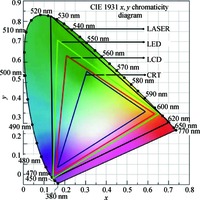
 DownLoad:
DownLoad:

